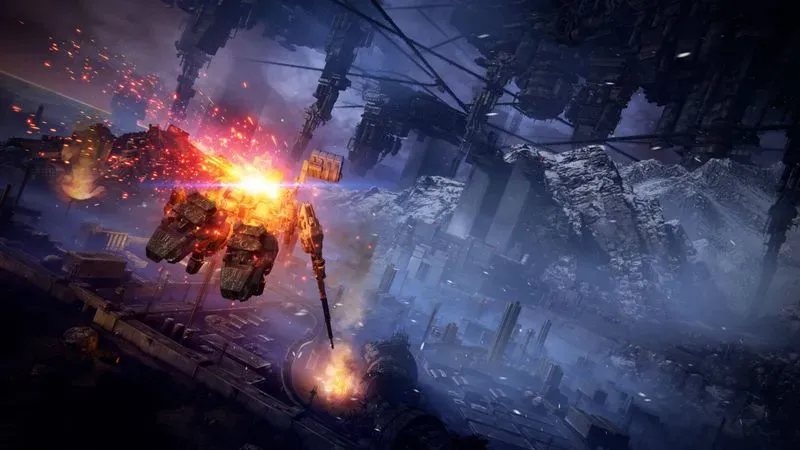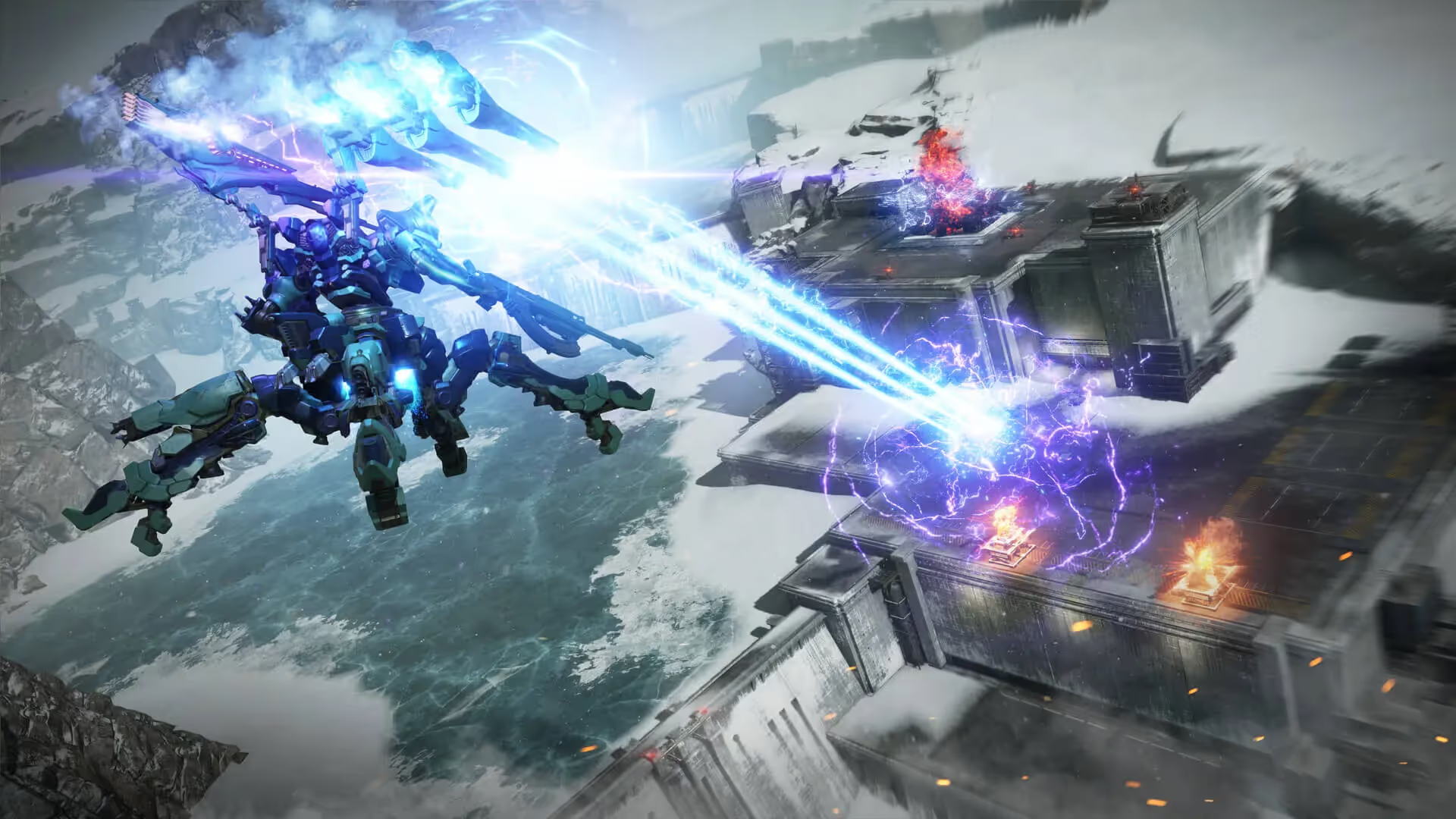PS5
PC
Xbox Series
PS4
Xbox One
Once the introductory cutscene is finished, and it has been made very clear that we're playing this game as a has-been in a mecha suit (let’s call our avatar Raven, as is the case in nearly all Armored Core titles), FromSoftware lets you play about in a tutorial-shaped sandbox, learning the controls and challenging you with some basic objectives and your first boss fight. And your first difficulty hump.
Playing through this – multiple times – told me a few things. One, this game has the polish of Elden Ring-era FromSoftware (it plays very well); two, your movement across the horizontal and the vertical is key; and three, if you're not a mecha-game aficionado then PlatinumGames’ Vanquish feels most similar to this, as you move around quickly to attack, dodge, defend and ultimately beat the baddies. And being likened to Vanquish is no bad thing (Ed's note - It was utterly brilliant).

Armored Core VI: Fires of Rubicon is the first entry into the 26-year old series since 2013's Armored Core V expansion, Verdict Day. A lot has happened to FromSoftware since then, namely the explosion of Soulslikes into the gaming world. Whilst we have an excellent game here, that's refreshingly where similarities end. This is all about a different type of combat (far more chaotic early-on, although button-bashing gets you nowhere fast as in beat-’em ups) and contrasting movement, as well as difficulty in seeing the woods for the trees on screen due to the bullet hell you're typically in AND linear progress down one of three paths (until NG+, at least). Where something has carried over from the Souls-series, but is also reminiscent of the series' past, is in customisation.
Kitting out your mecha is as involved as any racing game with liveries to spare and decals all over the shop. You want it to look cool, but importantly there is a solid functional aspect to it. You will repeatedly identify that your mech is just not equipped to take on a particular challenge, or beat that one boss. A key part of engagement in this game – the hunger depending on how much you dig it – is finding and collecting new parts to equip, allowing you to better compete in the current battle, or just to try something new. Upgrading and customising is essential to progress. You have quite a wide variety of options, being able to upgrade arms, legs, weapons and more on your mech. This all helps to make it move differently, faster, more easily, and kill different enemies in better ways than otherwise possible. As you progress in the game there is a definite feeling of things getting easier, which makes sense as you just become so much more powerful - and, importantly, experienced. Thankfully this is the case, as if it were just cosmetics such a feature would not appeal to a great many.
Gameplay on the surface is chaotic. With a third-person view your mecha can move in any direction, and at pace, but you'll need to get used to not turning in concert with the camera change you make. Meaning, if you point the camera in one direction but keep moving in the original direction, nothing resets. So you need to manually move your character as well. Not an issue, but it may take some getting used to. For movement you can walk, or boost wherever you want, but you'll need verticality too. Jumping is supported by a boost which allows you to gain height or move horizontally in the air, too. You can do quick movements left and right to aid dodging or shooting, and you can power forwards towards your targeted enemy to cover ground quickly.
All of this movement is key to success and the very best mecha pilots will be able to use each whenever required and combine it all in such a way to ensure maximum kills and minimum damage. Of course, that means you need to be attacking whilst moving, hence the chaos. You have guns, missiles and melee options and each enables success, but not alone. For example, you can shoot the enemies but ammunition has a cost, is limited and you can't just shoot non-stop as a result. Missiles allow for multiple contiguous targets but again, they're limited and slower. Melee means you of course need to be close to the target. Harnessing movement and attack together supports the best way to win, and survive. There're limited repair kits to help as well and checkpoints are generous ensuring massive Dark Souls-like redos are uncommon and therefore less frustrating to those who would get irritated by such a thing. If you do find yourself frustrated anyway, a lot of the mechanisms work in tandem and this is done to support you and your success. So if you find a mission's final boss tough and you need to change-up your kit, you can do that with what you already own without restarting the whole mission. If you need to get hold of something though, then it’s a full restart.

Your aim in the game is to complete missions and to obtain Coral (an energy source and way to transfer data long thought exhausted) for others with a view to obtaining a better life as a result. As you do this you get embroiled in a war with the ability to work with, and partner with, various factions. The ending of the game is dependent on the choices you make throughout the game's otherwise linear and old-school structure. You'll find tutorials built in as optional virtual missions, as well as just learning on the job by fighting, moving and speccing your mech differently to help that progress. A first playthrough will take up to twenty hours depending on ability – in true FromSoftware fashion there is no difficulty setting so what you get is what you beat. Or not. If you can get over the initial hurdles things get easier as you also get more powerful; there will still be spikes though for everyone, and some of those will require sustained patience (certain bosses in particular). There is then NG+ and beyond which add missions to the game and allow you to play for ranks, with an S-rank being the best, as you'd expect for a game coming from Japan. For anyone who completes the game I'd expect a strong desire to carry on – it's a wonderful piece of entertainment once you get started.
With Armored Core, then, we have a revived classic series done brilliantly well by some of the finest developers on the planet. It's tough, but accessible and it looks and plays as well as you'd hope on PlayStation 5, and better than might be expected given some of FromSoftware's past releases. The single-player mode is what brings us to the party, but multiplayer is there to provide a different challenge and give the chance to show off the mech-customisation skills you will undoubtedly earn. Don't expect a Soulslike experience, but do expect one akin to its quality and you'll be on the right track. Now, please excuse me as I have to go and S-rank a few more missions.
You can subscribe to Jump Chat Roll on your favourite podcast players including:
Let us know in the comments if you enjoyed this podcast, and if there are any topics you'd like to hear us tackle in future episodes!



